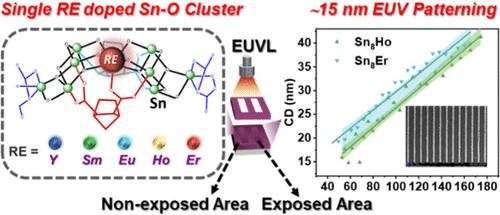Single Rare-Earth Ion Doped Tin-Oxo Nanocluster Photoresists for High-Resolution Extreme Ultraviolet Lithography
IF 9.1
1区 材料科学
Q1 CHEMISTRY, MULTIDISCIPLINARY
引用次数: 0
Abstract
Rare-earth (RE) metals are known as industrial vitamins and show significant regulatory effects in many fields. In this work, we first demonstrated that the vitamin effect of RE metals can also be applied to extreme ultraviolet (EUV) lithography. Using a Sn8RE oxo cluster as the universal platform, different individual RE metal ions were successfully doped to obtain a series of isomorphic heterometallic clusters (RE = Y, Sm, Eu, Ho, Er). Lithography experiments have shown that the doped RE ions displayed a significant influence on technical parameters. As a result, an electron-beam lithography (EBL) line width of 11.95 nm was achieved by Sn8Er, and an EUV lithography critical dimension (CD) of 15.90 nm was obtained by Sn8Ho under an exposure dose of 52.64 mJ/cm2. These findings expand the applications of rare earths in high-precision semiconductor manufacturing and provide a new strategy for the development of high-resolution EUV photoresists.

高分辨率极紫外光刻用单稀土离子掺杂锡氧纳米团簇光刻胶
稀土(RE)金属被称为工业维生素,在许多领域都显示出显著的调节作用。在这项工作中,我们首次证明了稀土金属的维生素效应也可应用于极紫外(EUV)光刻技术。以 Sn8RE 氧化物团簇为通用平台,成功掺杂了不同的单个 RE 金属离子,获得了一系列同构异金属团簇(RE = Y、Sm、Eu、Ho、Er)。光刻实验表明,掺杂的 RE 离子对技术参数有显著影响。结果,在 52.64 mJ/cm2 的曝光剂量下,Sn8Er 的电子束光刻(EBL)线宽达到 11.95 nm,Sn8Ho 的超紫外光刻临界尺寸(CD)达到 15.90 nm。这些发现拓展了稀土在高精度半导体制造中的应用,并为开发高分辨率超紫外线光刻胶提供了新策略。
本文章由计算机程序翻译,如有差异,请以英文原文为准。
求助全文
约1分钟内获得全文
求助全文
来源期刊

Nano Letters
工程技术-材料科学:综合
CiteScore
16.80
自引率
2.80%
发文量
1182
审稿时长
1.4 months
期刊介绍:
Nano Letters serves as a dynamic platform for promptly disseminating original results in fundamental, applied, and emerging research across all facets of nanoscience and nanotechnology. A pivotal criterion for inclusion within Nano Letters is the convergence of at least two different areas or disciplines, ensuring a rich interdisciplinary scope. The journal is dedicated to fostering exploration in diverse areas, including:
- Experimental and theoretical findings on physical, chemical, and biological phenomena at the nanoscale
- Synthesis, characterization, and processing of organic, inorganic, polymer, and hybrid nanomaterials through physical, chemical, and biological methodologies
- Modeling and simulation of synthetic, assembly, and interaction processes
- Realization of integrated nanostructures and nano-engineered devices exhibiting advanced performance
- Applications of nanoscale materials in living and environmental systems
Nano Letters is committed to advancing and showcasing groundbreaking research that intersects various domains, fostering innovation and collaboration in the ever-evolving field of nanoscience and nanotechnology.
 求助内容:
求助内容: 应助结果提醒方式:
应助结果提醒方式:


